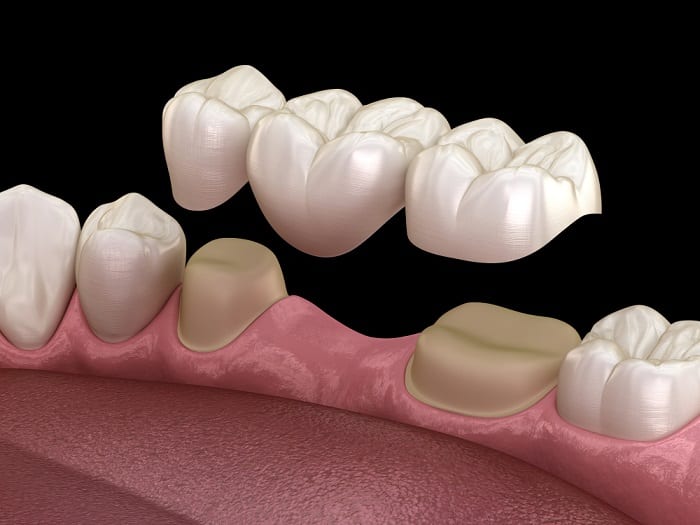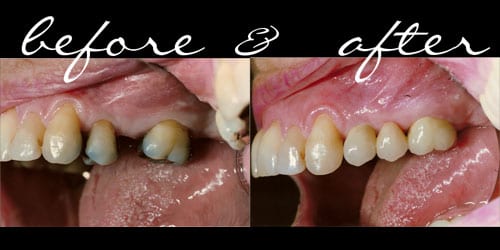Crown and bridge treatment is a permanent method of replacing missing teeth or small teeth, also known as microdontia. A crown is placed on an individual tooth, (somewhat like a thimble over your finger) where there is no longer sufficient tooth structure left to place a filling. Crowns could be needed as a result of cavities and tooth decay, or due to peg teeth (adult teeth that are smaller than normal).
A bridge spans a space where one or more teeth have been lost in the dental arch. The teeth on either end of the span are crowned, and are referred to as abutments. The false teeth in a bridge that join the abutments are referred to as pontics. View the diagram below which shows a traditional dental bridge to replace a missing tooth.

What Materials are Used in Crowns and Bridges?
Crowns and bridges are most often made from superior materials such as precious metals (gold and zirconium dioxide), porcelain, or a combination of metal fused to porcelain. Both cosmetic appearance and function are considered when selecting the material most suitable for a patient. 100% porcelain crowns are used in areas most visible when smiling. This allows for the most lifelike appearance.
How Can Crowns Improve a Smile?
Crowns fit over existing teeth, either hiding tooth decay or making teeth larger and more uniform. While fillings can be very visible, crowns are designed to match a patient’s existing tooth color and shape.
Peg teeth, also known as “Dracula teeth” are a unique reason a patient may want to consider either a crown or porcelain veneer. A crown placed on top of the peg tooth can make it normal sized and dramatically improve a patient’s smile.
How Is Treatment Performed?
At the first appointment a thorough oral examination, evaluation of your dental history and necessary X-rays are completed. The diagnosis is based on these three factors. Once it has been determined that crown and bridge treatment is indicated, you will be set up with a series of appointments. Note: It’s important that you keep all of these appointments. You see, your treatment occurs in a planned sequence. Missing or postponing your appointment may cause treatment delays, allowing further tooth movement before treatment can be completed.
Why Replace Missing Teeth?
Losing a tooth can be of social and psychological concern. Teeth are lost for a number of reasons including:
- Dental decay
- Periodontal (gum) disease
- Trauma (injury or accident)
When a permanent tooth is lost, the neighboring teeth are affected. Because the support and chewing forces are altered, the remaining teeth will begin to shift. The tooth above or below the one that was lost will begin to move up and out of its socket. This accelerates periodontal (gum) disease and causes further breakdown in the dental arch. If the missing tooth is not replaced, more teeth will eventually be lost, due to the improper forces exerted during chewing.
What Will Happen During a Procedure?
Whether you have a single tooth, or a row of teeth to be crowned, your dentist will numb with an anesthetic. Next, during the preparation phase, your teeth to be crowned are trimmed down. This allows sufficient space for the crown or bridge to fit.
After this prep stage has been completed, an impression of your mouth is taken. Modern impression materials provide an extremely accurate representation. This allows for the best possible restoration with crowns that are shaped, sized and fit properly. The shade of the crown will be matched to your natural teeth at your first appointment.
At the second appointment, the crown or bridge is adjusted for proper fit, prior to permanent placement. It is often necessary to fine trim and polish the new crown or bridge. Other factors we consider include:
- Aesthetics – color match and appearance
- Function – chewing and biting accuracy
- Tissue compatibility – the contour of the prosthesis must allow the surrounding tissue to conform to a natural, healthy position.
Replacing Missing Teeth:
- Helps restore and maintain the natural bite.
- Prevents unnatural stress on other teeth.
- Helps keep opposing teeth in their proper place.
- Prevents shifting and tilting of adjacent teeth.
- Helps prevent further dental decay and periodontal (gum) disease.
- Maximizes your smile, speech and chewing function.

A Final Word…
Throughout your crown or bridge treatment you may have questions or concerns. We will make every effort to minimize pain and provide peace of mind during your treatment. And we’re happy to answer any questions you may have. Our goal at Hancock and Johnston Dentistry is to help preserve your smile for a lifetime.

